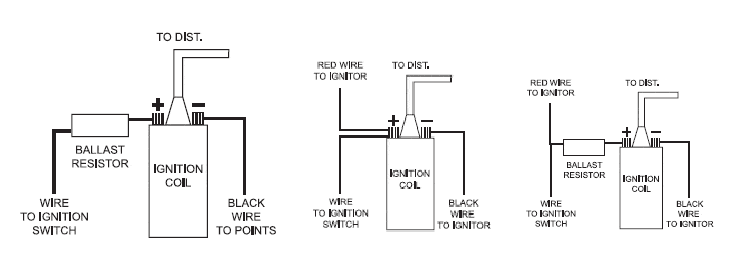Before installing, please read the following important information.
Many people running older flathead Continental and Wisconsin industrial engines have called us looking for a new solid-state distributor to replace an obsolete points-style distributor or an expensive magneto. They wanted to get away from constantly battling with wet points that needed constant adjusting or with obsolete magnetos for which parts are increasingly difficult to obtain. We now have Foley electronic ignition distributors to that will make life simple for you. These are designed for the common 12-volt negative ground applications found in Continental Red Seal and Wisconsin industrial engines. We list below some installation guidelines.
- The Foley electronic ignition is compatible only with a points style coil. 2, 3, and 4 cylinder engines and required a minimum of 3.0 ohms of resistance in the primary circuit. 6 cylinder engines may have a minimum of 1.5 ohms of resistance.
- If your system presently is equipped with a ballast resistor, do not remove it.
- The red wire from the distributor must be connected to the positive (+) side of the coil, or a 12-volt switching source. The black wire must be connected to the negative (-) side of the coil.
Prior to installation, turn the ignition switch off, or disconnect the battery.
- The electronic ignition distributor is installed into the engine block in the same manner as the conventional point distributor.
- For systems without a ballast resistor, connect the red wire to the positive (+) side of the coil. (See Figure 2)
- If a ballast resistor is used, connect the red wire to the ignition switch side of the resistor. (See Figure 3)
- In all cases the black wire should be connected to the negative (-) side of the coil.
- If the distributor is equipped with a vacuum advance, disconnect the vacuum hose at the distributor and plug it.
- Timing is performed in the standard manner. A conventional timing light is connected to the #1 cylinder spark plug wire, and the distributor body is rotated to achieve the proper timing.
- Since the Foley electronic ignition distributor will fire down to zero RPM, the engine can be statically timed to a high degree of accuracy.
- Set a voltmeter to a 12-volt DC scale.
- Connect the voltmeter from the negative (-) coil terminal to ground.
- With the key into the “on” position, as you turn the crankshaft the voltmeter will fluctuate between 1.2 volts and battery voltage.
- Firing occurs just as the voltmeter switches from 1.2 volts to battery voltage.
- Tighten distributor hold down, and reconnect all vacuum hoses.

Note: A resistor wire or ballast resistor may or may not be included in the original equipment. They are not to be changed in any way with the installation of an ignitor system.
Testing
If the engine will not start after installation or vehicle quits after starting, the following test may be done to check the system.
- Connect the positive (+) lead of a voltmeter to the negative (-) side of the coil. Connect the negative (-) lead of a voltmeter to an engine ground. Set the voltmeter to a 15-volt DC scale.
- Disconnect the high voltage wire from the center of the distributor cap, and ground it to the engine block or chassis.
- Crank the engine over a few turns while watching the voltmeter.
- The voltmeter should fluctuate from 1 or 2 volts to battery voltage as the engine rotates.
- If the voltmeter does not fluctuate, one of the following problems exist:
- If the voltmeter shows a constant 0 reading, there is an open circuit somewhere in the primary ignition. Check to make sure all connections are good and correct.
- If the voltmeter shows a constant voltage either low or high, the power transistor or hall cell may be damaged. A coil that requires a ballast resistor, the key being left on, or the reversed polarity connection could have caused this.
- If the voltmeter shows a fluctuation from 1 to 12 volts, and the engine does not run, check to ensure all other parts and functions of the engine are proper.
As mentioned above, it is important that your coil have the correct ohms with these distributors. We stock heavy-duty coils for industrial applications. Dr Diesel says that running a cheap auto parts store coil in your Wisconsin or Continental engine is not a good deal. See Foley Tech Tip #39, How To Install an Ignition Coil. At the same time you should install a new set of Champion UD16 plugs or their equivalent in your Continental or Wisconsin engine. See Tech Tip #56, Spark Plug 101 for more info on spark plugs. Finally, these new solid-state distributors run much better with a set of performance plug wires. We recommend that you use ACCEL wires and could ship you a set of these high performance wires today.
For people who want to tune up their Perkins 4236 gas engine or Wisconsin or Continental industrial engine, we stock Workshop Manuals and can ship them right out to you. Please call us toll free at 800 233 6539 to order.
For additional technical assistance, please feel free to email our tech support people at TechSupport@FoleyEngines.com or you can email Dr Diesel directly at DrDiesel@FoleyEngines.com. Foley is different: we are a 95 year old firm that wants to help!




